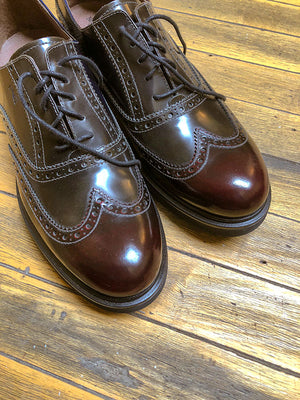When 'Made in Italy' meant 'Made in Italy'
Yesterday I purchased a new pair of shoes. I was working at my design studio and wanted to take a break, so I decided to head down to one of the better shoe stores in Saskatoon. I arrived at 5:00 with only a half hour until the store closed. I did a quick scan of the shoes and made my way to the ‘Sale’ section. There, my eyes landed on the last pair of shoes (in my size) that would be anywhere close to something I could walk in. “Robust" was what I was looking for and these were the shoes. They were beautiful and one of my favourite styles in a shoe (brogues). The price tag said $340. What caught my eye was the stamp on the bottom of the shoe - Made In Italy - which weighed-in heavily on piquing my interest to go a step further (no pun intended).

I knew they must be quality! And they were on sale for $85. This was my day! I tried them on and they were a little sloppy, but thought I might be able to 'fudge' it for fit, if I had an insole to fill up the space.
With only half an hour before the store closed at 5:30 (it was the last day of the sale), I said to the store clerk, "Do you have anything resembling an insole"? She found an insole and I tried the shoe on. Still a little sloppy for fit, but I felt my own insoles could work in the shoe. "Ok, I'll take them," I said.

I brought my new shoes home, and I felt good that I’d gotten a ‘deal’ for $85. When I proudly showed my husband my new shoes, he asked if he could wear them, too!

Here I revisit my original thought while in the store; part of what influenced my decision was 'Made in Italy'. I grew up knowing that if something was Made in Italy, it had to be good; authentic and well made. But as I looked closer at the shoe, I saw that while sporting beautiful leather uppers, they did not have soles that could be repaired.

The soles weren't stitched onto the upper but glued (as is most often the case these days). I could have paid the full $340 for shoes that couldn't be repaired when the soles wore out. This is what got me to thinking and remembering reading some years ago about how "Made in Italy" no longer means what we think. More often than not now, 'Made in Italy' can mean, a number of disparate elements of a product – in this case my shoes - can be made elsewhere in the world and shipped back to Italy and assembled there. I suspect this was the case.


4 comments
Kathleen,
I did that exact same purchase back in 1990. The shoes are almost exactly the same except older with leather soles. They too are made in Italy. I wore them everyday for years. Now they don’t get as much wear but are a classic so go with everything. The brand name was Gregor. I paid $ 240.00 then and people thought I was crazy but good shoes are very hard to come by. All I did to keep them timeless is to wax and buff often for the first 5 years. They still look brand new.